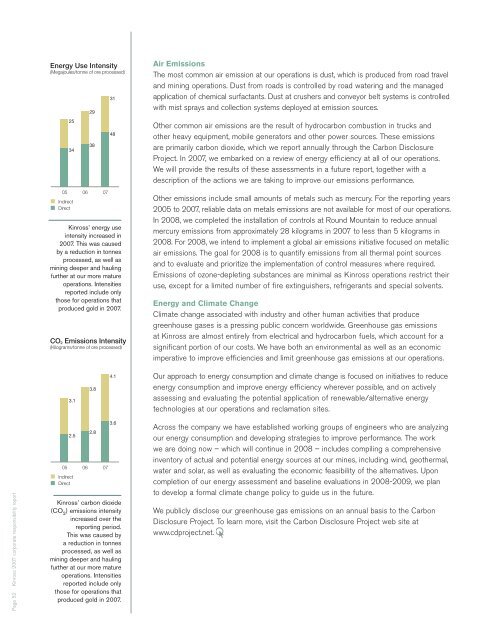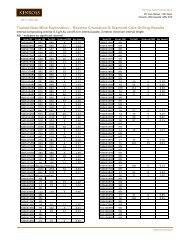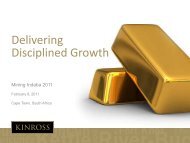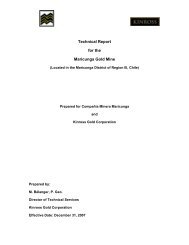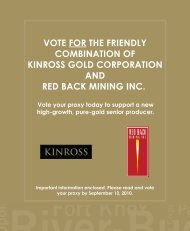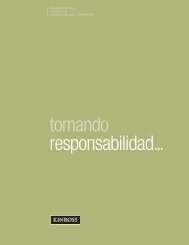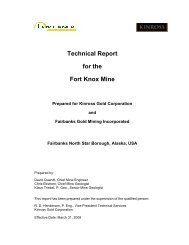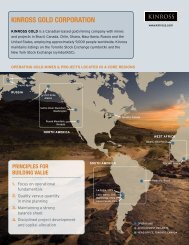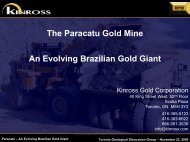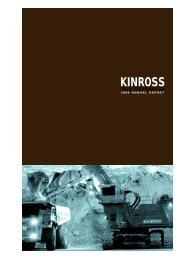2007 Full Report - Kinross Gold
2007 Full Report - Kinross Gold
2007 Full Report - Kinross Gold
Create successful ePaper yourself
Turn your PDF publications into a flip-book with our unique Google optimized e-Paper software.
Energy Use Intensity(Megajoules/tonne of ore processed)253405 06IndirectDirect2938073148<strong>Kinross</strong>’ energy useintensity increased in<strong>2007</strong>. This was causedby a reduction in tonnesprocessed, as well asmining deeper and haulingfurther at our more matureoperations. Intensitiesreported include onlythose for operations thatproduced gold in <strong>2007</strong>.CO 2 Emissions Intensity(Kilograms/tonne of ore processed)Air EmissionsThe most common air emission at our operations is dust, which is produced from road traveland mining operations. Dust from roads is controlled by road watering and the managedapplication of chemical surfactants. Dust at crushers and conveyor belt systems is controlledwith mist sprays and collection systems deployed at emission sources.Other common air emissions are the result of hydrocarbon combustion in trucks andother heavy equipment, mobile generators and other power sources. These emissionsare primarily carbon dioxide, which we report annually through the Carbon DisclosureProject. In <strong>2007</strong>, we embarked on a review of energy efficiency at all of our operations.We will provide the results of these assessments in a future report, together with adescription of the actions we are taking to improve our emissions performance.Other emissions include small amounts of metals such as mercury. For the reporting years2005 to <strong>2007</strong>, reliable data on metals emissions are not available for most of our operations.In 2008, we completed the installation of controls at Round Mountain to reduce annualmercury emissions from approximately 28 kilograms in <strong>2007</strong> to less than 5 kilograms in2008. For 2008, we intend to implement a global air emissions initiative focused on metallicair emissions. The goal for 2008 is to quantify emissions from all thermal point sourcesand to evaluate and prioritize the implementation of control measures where required.Emissions of ozone-depleting substances are minimal as <strong>Kinross</strong> operations restrict theiruse, except for a limited number of fire extinguishers, refrigerants and special solvents.Energy and Climate ChangeClimate change associated with industry and other human activities that producegreenhouse gases is a pressing public concern worldwide. Greenhouse gas emissionsat <strong>Kinross</strong> are almost entirely from electrical and hydrocarbon fuels, which account for asignificant portion of our costs. We have both an environmental as well as an economicimperative to improve efficiencies and limit greenhouse gas emissions at our operations.3.13.84.1Our approach to energy consumption and climate change is focused on initiatives to reduceenergy consumption and improve energy efficiency wherever possible, and on activelyassessing and evaluating the potential application of renewable/alternative energytechnologies at our operations and reclamation sites.Page 52 <strong>Kinross</strong> <strong>2007</strong> corporate responsibility report2.505 06IndirectDirect2.8073.6<strong>Kinross</strong>’ carbon dioxide(CO 2 ) emissions intensityincreased over thereporting period.This was caused bya reduction in tonnesprocessed, as well asmining deeper and haulingfurther at our more matureoperations. Intensitiesreported include onlythose for operations thatproduced gold in <strong>2007</strong>.Across the company we have established working groups of engineers who are analyzingour energy consumption and developing strategies to improve performance. The workwe are doing now – which will continue in 2008 – includes compiling a comprehensiveinventory of actual and potential energy sources at our mines, including wind, geothermal,water and solar, as well as evaluating the economic feasibility of the alternatives. Uponcompletion of our energy assessment and baseline evaluations in 2008-2009, we planto develop a formal climate change policy to guide us in the future.We publicly disclose our greenhouse gas emissions on an annual basis to the CarbonDisclosure Project. To learn more, visit the Carbon Disclosure Project web site atwww.cdproject.net.


